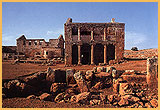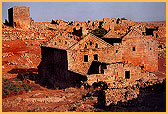|
The villages of the limestone massif
of Belus
Like the southern Syrian massifs of Hauran and
Djebel el-Arab, th e
nothern Limestone Plateau, was rich and densely populated
for many centuries despite its marginal setting. Here individual
farmers prospered thanks to diversified crops (olive oil,
wine, cereal, fruit and vegetables), the surplus of which
they sold, stock raising, and a tenacious habit to defy imperial
tax collectors. As many as seven hundred villages, many of
them almost perfectly preserved to this day, are scattered
in the region. Built in a finely cut limestone masonry, they
consist of clusters of houses and the occasional public building,
such as a church, a bath, a hostel or a tavern, separated
by narrow tortuous streets and e
nothern Limestone Plateau, was rich and densely populated
for many centuries despite its marginal setting. Here individual
farmers prospered thanks to diversified crops (olive oil,
wine, cereal, fruit and vegetables), the surplus of which
they sold, stock raising, and a tenacious habit to defy imperial
tax collectors. As many as seven hundred villages, many of
them almost perfectly preserved to this day, are scattered
in the region. Built in a finely cut limestone masonry, they
consist of clusters of houses and the occasional public building,
such as a church, a bath, a hostel or a tavern, separated
by narrow tortuous streets and  irrregular
open plazas. It seems that the farmers invested much of their
riches in their elegant dwellings, which usually include a
main house and various annexes, such as oil and wine presses.
Both house and annexes give onto a courtyard and communicated
with the outside by a single door. The main house is often
two- or three-storeyed, the ground floor being used for storage
and animals, the top ones as living quarters. It has
galleries, balconies
and ceilings of stone. Elegant mouldings run across the faŤades,
and frame the doors and windows. However, all houses lack
basic amenities such as heating and sanitation, and were probably
shared by more than one families. irrregular
open plazas. It seems that the farmers invested much of their
riches in their elegant dwellings, which usually include a
main house and various annexes, such as oil and wine presses.
Both house and annexes give onto a courtyard and communicated
with the outside by a single door. The main house is often
two- or three-storeyed, the ground floor being used for storage
and animals, the top ones as living quarters. It has
galleries, balconies
and ceilings of stone. Elegant mouldings run across the faŤades,
and frame the doors and windows. However, all houses lack
basic amenities such as heating and sanitation, and were probably
shared by more than one families.
|